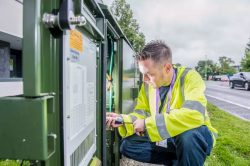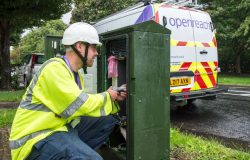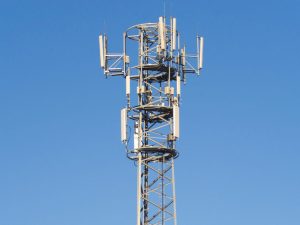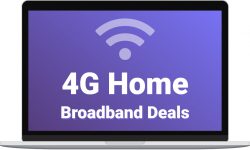You’ll often see terms like superfast and ultrafast broadband when comparing fibre broadband providers.
 In the UK, you’ll often see terms like “superfast fibre” and “ultrafast fibre” when comparing home broadband services. These terms are intended to distinguish different categories of home broadband, based on the maximum download speed that’s available on the service.
In the UK, you’ll often see terms like “superfast fibre” and “ultrafast fibre” when comparing home broadband services. These terms are intended to distinguish different categories of home broadband, based on the maximum download speed that’s available on the service.
In this article, we’ll look at the different types of home broadband in the UK. We’ll also look at the definitions of “standard broadband”, “superfast broadband” and “ultrafast broadband” before comparing different broadband technologies in more detail.
Contents
Superfast & Ultrafast Fibre Broadband
 In the UK, you’ll often see home broadband services being marketed as “superfast broadband” or “ultrafast broadband”. This is based on the maximum download speed available on the service, with the official definitions from Ofcom (the UK’s regulator for telecommunication services) being as follows:
In the UK, you’ll often see home broadband services being marketed as “superfast broadband” or “ultrafast broadband”. This is based on the maximum download speed available on the service, with the official definitions from Ofcom (the UK’s regulator for telecommunication services) being as follows:
- Standard broadband (download speeds of less than 30Mbps). All home broadband services delivered through ADSL technology using a BT Openreach phone line fall within this category.
- Superfast broadband (download speeds of 30Mbps to 300Mbps). The term ‘superfast broadband’ is used to distinguish home broadband services with a download speed of more than 30Mbps. This includes all fibre-to-the-cabinet (FTTC) services as well as the lower tiers of Virgin’s cable-based home broadband service. Broadband that’s delivered through G.fast or 4G technology would also normally be classified as offering superfast speeds.
- Ultrafast broadband (download speeds of more than 300Mbps). Ultrafast broadband refers to services offering a download speed of more than 300Mbps. Full fibre services (also known as fibre-to-the-home or FTTH) are the gold standard within this category. However, the higher tiers of Virgin Media’s cable-based broadband and 5G broadband would also count as ultrafast broadband. Prior to 2015, the threshold for ultrafast broadband was only 100Mbps. Some ISPs continue to use the old definition, marketing their G.fast services as ultrafast broadband even though they offer download speeds of less than 300Mbps.
 It’s worth noting that Ofcom’s official definitions are fairly one-dimensional when it comes to broadband speed. It ignores lots of other factors such as the upload speed available and the ease of actually getting the maximum available speed.
It’s worth noting that Ofcom’s official definitions are fairly one-dimensional when it comes to broadband speed. It ignores lots of other factors such as the upload speed available and the ease of actually getting the maximum available speed.
To give an example, full fibre (or fibre-to-the-home) services tend to offer symmetrical speeds where you can upload at the same speed you download. This is beneficial for things like cloud-based storage where you often need to upload lots of data. Other broadband types like cable normally have asymmetric speeds where uploads are substantially slower than downloads. Another factor that’s missed out is the difference between actual and maximum speeds. For instance, you’ll normally only be able to get a fraction of the maximum possible speed when using 4G or 5G home broadband. Meanwhile, cable or fibre-based broadband will normally give you close to the maximum advertised speed.
Other terms that are sometimes in use include Hyperfast and Gigafast. These terms don’t have a standard industry-recognised meaning: they’re just marketing terms used by certain internet service providers to describe their own service.
Broadband Plans By Speed
The following table shows how much you would need to pay for a home broadband service at a range of different download speeds. It also shows the percentage availability amongst UK households:
| Download Speed | Monthly Price | Availability |
|---|---|---|
| 10Mbps | From £26.95/month | 98% of UK households |
| 36Mbps | From £17.99/month | 95% of UK households |
| 50Mbps | From £25.00/month | 95% of UK households |
| 67Mbps | From £22.99/month | 95% of UK households |
| 100Mbps | From £18.99/month | 60% of UK households |
| 150Mbps | From £24.99/month | 60% of UK households |
| 200Mbps | From £23.99/month | 60% of UK households |
| 300Mbps | From £28.99/month | 60% of UK households |
| 500Mbps | From £22.99/month | 50% of UK households |
| 900Mbps | From £24.99/month | 20% of UK households |
UK Broadband Providers
The following table shows a list of internet service providers (ISPs) in the UK. For each ISP, we’ve shown whether they offer standard, superfast and ultrafast broadband services. We’ve also shown the type of technology that is used for each one as this is often much more informative and relevant to what you can do with the service:
| Internet Service Provider (ISP) |
Standard Broadband (<30Mbps) |
Superfast Broadband (30-300Mbps) |
Ultrafast Broadband (>300Mbps) |
|---|---|---|---|
| BT Broadband | ✔ ADSL | ✔ FTTC & G.fast | ✔ Full Fibre |
| EE | ✔ ADSL | ✔ FTTC, G.fast & 4G | ✔ Full Fibre |
| Hyperoptic | ✘ | ✘ | ✔ Full Fibre |
| Now Broadband | ✔ ADSL | ✔ FTTC | ✘ |
| Post Office | ✔ ADSL | ✔ FTTC | ✘ |
| Plusnet | ✔ ADSL | ✔ FTTC | ✘ |
| SSE | ✔ ADSL | ✔ FTTC | ✘ |
| TalkTalk | ✔ ADSL | ✔ FTTC & G.fast | ✔ Full Fibre |
| Three | ✘ | ✔ 4G | ✔ 5G |
| Shell Energy | ✔ ADSL | ✔ FTTC | ✘ |
| Sky Broadband | ✔ ADSL | ✔ FTTC & G.fast | ✔ Full Fibre |
| Virgin Media | ✘ | ✔ DOCSIS Cable | ✔ DOCSIS Cable |
| Vodafone | ✘ | ✔ FTTC & 4G | ✔ Full Fibre & 5G |
On full fibre (fibre to the home or FTTH) services, your connection will normally always be capable of achieving gigabit download speeds (1Gbit/s or 1,000Mbps). However, on some cheaper price plans, the download speeds might be restricted (e.g. sometimes down to as little as 50Mbps or 100Mbps). This technically brings the service within the realm of offering superfast speeds, although the line is technically capable of providing ultrafast speeds.
Broadband Technologies
In our opinion, it’s far more meaningful to look at the actual broadband technology used rather than relying on top-level categorisations such as “superfast” or “ultrafast”. This will tell you a lot more about how the broadband service is delivered, along with what you can do with it and the associated pros and cons.
The technologies used to provide home broadband in the UK are as follows:
| Broadband Technology | Maximum Download Speed | Maximum Upload Speed | Average Download Speed | Average Upload Speed |
|---|---|---|---|---|
| ADSL | Up to 17Mbps | Up to 1.5Mbps | 11Mbps | 0.8Mbps |
| FTTC | Up to 80Mbps | Up to 20Mbps | 60Mbps | 18Mbps |
| G.fast | Up to 300Mbps | Up to 50Mbps | 280Mbps | 45Mbps |
| DOCSIS Cable | Up to 1,104Mbps | Up to 54Mbps | 1,104Mbps | 54Mbps |
| Full Fibre | Up to 1,000Mbps | Up to 1,000Mbps | 1,000Mbps | 1,000Mbps |
| 4G Wireless | Up to 450Mbps (Cat9) | Up to 50Mbps | 15-30Mbps | 8-10Mbps |
| 5G Wireless | Up to 1,000Mbps | – | 150-250Mbps | 80-100Mbps |
ADSL
A standard home broadband service that’s delivered through your BT Openreach phone line uses a copper connection between your home and the telephone exchange.
With ADSL (Asymmetric Digital Subscriber Line) technology, it’s possible to obtain download speeds of up to 17Mbps and upload speeds of up to 1.5Mbps. Actual download speeds will depend on the distance between your home to the telephone exchange, with average speeds normally being in the region of 10Mbps.
Almost all UK homes can get access to ADSL broadband.
FTTC (Fibre To The Cabinet)
 The majority of fibre broadband services sold in the UK are actually fibre-to-the-cabinet services, or FTTC for short.
The majority of fibre broadband services sold in the UK are actually fibre-to-the-cabinet services, or FTTC for short.
With FTTC, a fibre connection is used from the telephone exchange to your nearest green street cabinet. That’s as far as the fibre connection goes, and a copper connection is then used from the street cabinet to your home (what’s often referred to as the “last mile” connection).
With FTTC, it’s possible to obtain download speeds of up to 80Mbps and upload speeds of up to 20Mbps. Actual speeds in reality depend on the distance between your home and the street cabinet but average download speeds are normally in the region of 60Mbps.
Around 91% of UK homes are able to get a fibre-to-the-cabinet service.
G.fast
G.fast is a hybrid technology that brings the fibre connection one step closer to your home. Rather than the fibre optic cable stopping at your nearest street cabinet, it goes one step further and ends at a G.fast pod that’s installed on your nearest telephone pole or pavement chamber.
The “last mile” connection between the G.fast pod and your home still uses a traditional copper cable. However, as the amount of copper is greatly reduced, you can get maximum download speed of up to 300Mbps and maximum upload speeds of up to 50Mbps. Average speeds vary in practice but you can often see an average download speed of around 280Mbps.
Around one million UK homes currently have access to G.fast broadband.
DOCSIS Cable
 In the UK, Virgin Media provides a home broadband service using cable and a technology known as DOCSIS. Technically speaking, DOCSIS is a fibre-to-the-cabinet service but it uses co-axial cables (Hybrid Fibre Coax) between the cabinet and your home. This means performance is a lot better than on regular FTTC which uses basic copper cables rather than a HFC cable.
In the UK, Virgin Media provides a home broadband service using cable and a technology known as DOCSIS. Technically speaking, DOCSIS is a fibre-to-the-cabinet service but it uses co-axial cables (Hybrid Fibre Coax) between the cabinet and your home. This means performance is a lot better than on regular FTTC which uses basic copper cables rather than a HFC cable.
On Virgin’s latest Gig1 broadband service, it’s possible to obtain download speeds of up to 1Gbit/s. This uses the latest version of DOCSIS 3.1. Upload speeds of 54Mbps are available (this is an asymmetric service unlike full fibre connections). In areas where Gig1 broadband is not yet available, Virgin Media offers download speeds of up to 500Mbps.
Full Fibre (Fibre To The Home)
The gold standard for home broadband is full fibre (also known as fibre-to-the-home or FTTH). The fibre optic cable runs all the way into your home, meaning you’ll you get the highest possible speeds.
Today’s full fibre services offer up to 1Gbps symmetrical speeds: that’s 1,000Mbps on both the download and upload. Typically, these speeds are marketed as 900Mbps. In the future, even higher speeds should become available as newer hardware takes advantage of the fibre optic cable.
Although full fibre services can offer gigabit speeds in both directions, some full fibre services are sold with slower speeds. This is used to make the service more affordable as many people do not require the maximum available speed.
4G Wireless
 As an alternative to receiving broadband through a phone line or cable, it’s also possible to get home broadband through 4G technology. Here, a wireless connection is used between your home broadband router and the nearest 4G mobile mast.
As an alternative to receiving broadband through a phone line or cable, it’s also possible to get home broadband through 4G technology. Here, a wireless connection is used between your home broadband router and the nearest 4G mobile mast.
With Category 9 LTE technology, it’s possible to get download speeds of up to 450Mbps and upload speeds of up to 50Mbps. In practice, however, speeds on 4G are normally much slower than the maximum. This is due to signal strength not being perfect and due to resources on the mast being shared with other users (contention). A more typical range for download speeds on 4G home broadband is 15-30Mbps.
5G Wireless
5G is the next generation of wireless home broadband, offering download speeds of up to 1Gbps.
Today’s 5G home broadband services will give you an average download speed of around 100Mbps. It’s possible, however, to get higher download speeds than this if in you’re in an area with good 5G coverage and with plenty of capacity.
More Information
For more information, you can read our in-depth reviews of BT Broadband, EE Broadband, Hyperoptic, Shell Energy Broadband, Sky Broadband, TalkTalk Broadband, Three Broadband, Virgin Media and Vodafone Broadband.


Geoff. D said:
How far does/can a 150 mbps. signal travel along a ‘fibre optic’ cable in 1 second (converting this to say Miles or Km per Second) ?
Everyone seems to answer ‘speed’ in relation to what you can download, whereas I am more interested in the distance the signal travels on average in a given time.
Does anyone know how to work this out ?
Ken replied:
Hi Geoff,
Thanks for your comment. Light travels at a speed of about 2.1 x 108 m/s in a fibre optic cable. However, the speed of your internet connection doesn’t really relate to this figure at all. It’s more to do with how much data can be transmitted each second which is a function of things like the hardware you’re using at each end of the cable, the plan you’re on, etc.
To illustrate, imagine if I were to transmit a message to you using a flashlight and morse code. The light would be travelling to you at the speed of light. However, you would probably only be able to receive one letter every couple of seconds, so the rate of data transfer is actually quite low (despite the speed of light being very high). We could maybe improve this (e.g. using multiple torches at the same time, using a machine at each end to send and receive the signal) but this doesn’t relate making the light travel faster.
Therefore, whether you’re using a 150Mbps connection, a 900Mbps connection, or anything else, the speed of light will remain constant across the two.
Hope this helps,
Ken
GeoffD replied:
Thank you Ken.
I was aware that I was talking about “incompatibles”, and I understand you explanation, but somewhere there must be an easy formula to calculate how quickly a given size of data (say 1Mb can be transmitted via a fibre optic cable “of a known quality” over a unit of distance (say 100 miles) given a signal rated at (say 100 Mbps) ? I tried to keep it metric. Perhaps the cable manufacturers will have worked this out ? I ask this to calculate the delay I experience when my Landline telephone (Connected via the Fibre optic cable) calls Belfast. It is clearly a different delay when I call my friend locally. Have you any further ideas/comments? Thanks GeoffD.
Ken replied:
Hi Geoff,
Thanks for the reply! Sadly, I think the delay is more related to how long it takes for the data to be processed by different servers and for it to find it’s way across the internet. Have a look at ping, latency and jitter as related concepts. So sadly, there isn’t an easy formula we can use to calculate this 🙁
Ken
Stephen replied:
Hi, I think the ‘delay’ you’re referring to is called latency. Latency is good on ADSL , fibre to the cabinet and fibre to the premises. The latter is the technology behind 500mb broadband. If you search for this or look at the ‘ping’ results from a broadband speed tester it should give an indication. hope this helps!
EdShift said:
I’m with Virgin and I’m getting a solid 10 megabytes per second download speed from Steam.
I’m connected over Wi-Fi with one range extender directly above upstairs from the router.
Very impressive.
Christopher Jesty said:
I subscribe to my service provider for a download speed of 300mbps and upload of 50mbps. In reality the download speed sometimes exceeds 300mbps however, I simply cannot watch TV channels because of severe buffering. I have an ethernet connection rom my TV box to my latest state of the art modem and my Fibre Optic replaced the old copper wire only last week. I thought that by upgrading to 300mbps all my streaming problems would be over but I am still frustrated at not being able to enjoy watching my favorite channels.
the concerned individiual replied:
Buffering over LAN can only mean one thing – congestion during times you are watching movies, either by the supplier (usually at peak time – if all the time it’s serious and should be fixed) or having 3 kids upstairs on an Xbox
H Wainwright said:
Thanks for the interesting article. I wonder if you have any opinion on fibre to mast which seems to be what BT/Openreach are suggesting for the suburbs of Sheffield instead of fibre to home for their Cityfibre project.
Ken replied:
Hi there,
Thanks for your comment. I believe BT were previously deploying Gfast technology in some areas which can give download speeds of up to 330Mbps (so somewhere in between regular fibre broadband and fibre-to-the-premises). However, I believe this has now been halted and the focus is very much on FTTP (fibre to the premises). I’m not aware of any ongoing major Gfast deployments?
Ken
Fred replied:
I just signed up for AT&T’s Fiber Internet 500, and a speed test after installation shows me getting speeds even faster than 500 mbps. But nobody mentions that download speed isn’t based solely on your own Internet connection. It’s also dependent upon the speed of the person uploading the file. And so far, in a few days of testing,I’ve never encountered a download clocked at over 5 or 6 mbps, And most of them are a lot slower. So in practical terms, what good does it do you to have a superfast connection if most real-life download speeds are 100 times slower than what you are capable of receiving?
Christian replied:
the main benefits are going to be for those who have larger home networks, i.e. many users or devices reaching out to the web at the same time. as well as those downloading games and other large files from places that don’t throttle connections like that, steam (a popular PC gaming marketplace) does not cap your speeds as far as I have found.
Pedro said:
Just got virgin 1gbps and it’s mind blowing, full had movie downloads when hardwired lan connection to series x 20 seconds total download time.
Also great for game updates and big game download no more hours waiting for a game to download, now more like minutes.
Sally Craig said:
Thank you so much for providing this very readable and instantly helpful information on broadband. I really appreciate your website.
Keith Goddard said:
Today I am getting connected with “UPP broadband” service which is new to the area, they have some blinding reviews, I’ve gone with their 900meg package from a dire 55mb which is the best I can get from BT which is a company that must be hemorrhaging customers to other ISP’s due to their ignorance from the people at the top,
To give you an example of how antiquated BT is, they are asking £40pm for that 55mb, whereas UPP are asking the same price but for a staggering 900mb?
BT and other ISP’s are getting left behind and it’s coming to them a BIG shock with other more customer focused companies who are connected to their customers and know they are crying out for a better speed.
Bill said:
So what I can gather from this unless your house hold is in excess of 100 people then you will not see any day to do benefit from moving from a 50-60mbps broadband to a 500mbps broadband?
John replied:
If you had a house hold with 100 people and each only using 0.1-1Mbps per person/device then yeah you may only need 50-60mbps but I’m pretty confident that some of your devices/person will use more then that so therefore having a fast connection would mean you could do more in less time. It all depends on what your doing/downloading/watching/gaming etc
Graeme Claridge said:
The age of the slower broadband provider is coming to an end, in fact, as far as Lowestoft is concerned, that age is now over because Ultrafast Fibre is here, Gigabit broadband is now a reality in the town.
I shall be connected to the Gigabit service in just 2 weeks time and I shall have a 500 mbps connection, a massive step up on my current BT Infinity service.
If you live in Lowestoft then go for it, it’s the best choice and to paraphrase Del Boy from Only Fools and Horses, “You Know It Makes Sense”.
the concerned individiual replied:
Virgin I bet? – they have had serious congestion issues for 10 years due to their high speed options, its just “too costly” to provide the needed bandwidth to keep everyone at +/-500Mbps 24/7
PHILIP PRENTICE said:
I am one of the lucky ones living in a cabled area and signed up for 200mbps.
I am less lucky though in that, whilst it may be possible in theory to get this kind of service, in practice it is often in the 35-50 mbps range and sometimes even achieving 0mbps.
Many others in the area experience the same but the ISP refuses to accept there is a problem. They simply suggest that we pay yet more for a higher service but without providing any guarantee on what will actually be delivered.
Denise Hall replied:
Yes exactly I gave this same scenario and it’s a liberty as costs are so high 😩